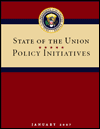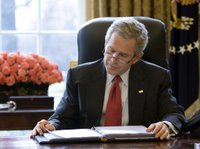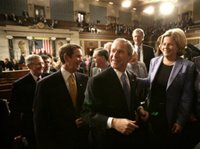UPDATE: 01/23/07 10:30 P.M. EST. State of the Union Address 2007 FULL STREAMING VIDEO, PODCAST of Speech mp3 format for download. Streaming Audio of speech mp3 in m3u format for online listening. FULL TEXT of Speech and a Photo Gallery of Speech

2007 State of the Union Address Policy Initiatives, Full PDF Document (138KB)
State of the Union Address Outlines President’s Agenda, 2007 State of the Union Policy Initiatives (POINT by POINT PREVIEW), Bush’s address to Congress and the nation. Traslations of this Article: Русский, Russian. Español, Spanish. Français, French. 
2007 State of the Union Address Policy Initiatives, Full PDF Document (138KB)
 , Arabic, PODCAST FOR THIS ARTICLE.
, Arabic, PODCAST FOR THIS ARTICLE.Washington -- President Bush is scheduled to deliver his State of the Union address this evening to Congress, the nation and a worldwide television and Internet audience.
The U.S. Constitution requires that the president report to Congress "from time to time" on the "State of the Union." This constitutional requirement has evolved into the president's annual State of the Union address, which now serves several purposes. The speech reports on the condition of the United States both domestically and internationally, recommends a legislative agenda for the coming year and gives the president the opportunity to convey personally his vision for the nation.
In his 2006 speech, Bush urged the United States to engage the international community as a means of building prosperity, security, freedom and hope around the world. (VIDEO, PODCAST and TEXT of 2006 State of the Union Speech) The tradition of the State of the Union address dates back to 1790 when George Washington, the first U.S. president, delivered his "Annual Message" to Congress in New York City, then the provisional capital of the United States. His successor, John Adams, followed suit.
But the nation's third president, Thomas Jefferson, felt that such elaborate displays were not suitable for the new democratic republic. He delivered a written message rather than appearing in person. Jefferson's influence was such that for more than a century thereafter presidents delivered written Annual Messages to Congress.
In the early decades of the republic, most of these messages were lists of bills the president wanted the Congress to enact -- reflecting the tenor of the times and the practical problems involved in building the young American nation. The speeches also dealt with the international situation and America's place in the world.
During the crisis that, more than any other, threatened the very existence of the American union -- the Civil War -- Abraham Lincoln wrote perhaps the most eloquent and memorable of all presidential messages sent to Congress.
"In giving freedom to the slave, we assure freedom to the free -- honorable alike in what we give and what we preserve," wrote Lincoln in 1862.
In 1913, Woodrow Wilson revived the practice of delivering the Annual Message in person. This was a timely decision because the United States was on the eve of a mass media revolution that soon would bring presidents into the homes of Americans, first through radio, then by television.
With the election of Franklin Delano Roosevelt in 1932, Americans became accustomed to hearing their presidents on radio as well as to seeing and hearing them on the newsreels at the movies.
In 1945, the Annual Message formally became known as the State of the Union address. It also became a television, as well as radio, staple as sales of television sets skyrocketed in the 1950s. In recognition of the power of television to deliver the president's words to a huge audience, President Lyndon Johnson shifted the time of the address from the traditional midday to evening when more viewers could watch.
The tradition of the opposition response began in 1966 when two Republican congressmen, including future President Gerald Ford, delivered a televised Republican response to President Johnson's State of the Union address.
The broadcast of the State of the Union address on television and the wide national and international audience it attracts -- an estimated 38 million viewers watched Bush's 2005 address -- have changed the fundamental nature of the message, according to political observers.
The 2007 address will mark the 218th Annual Message or State of the Union address and the 74th such address delivered in person. Although there will be a major focus on domestic issues, both American and overseas observers will be listening closely to the president's words as he outlines his vision for the nation in the upcoming year and beyond.
USINFO will publish both the full text of the address and a summary of its key elements related to U.S. foreign policy.
(Distributed by the Bureau of International Information Programs, U.S. Department of State. Web site: usinfo.state.gov )
Traslations of this Article: Русский, Russian. Español, Spanish. Français, French.
 , Arabic
, ArabicTechnorati Tags: President Bush and White House or Supreme Court and State of the Union Address, or Senate and Congress, or Article II, and U.S. Constitution, or VIDEO, and PODCAST,
















No comments:
Post a Comment